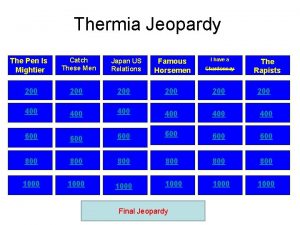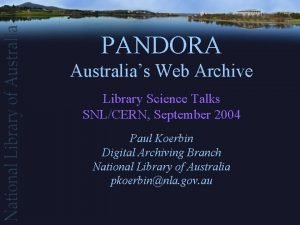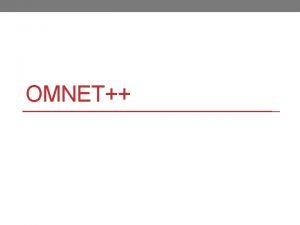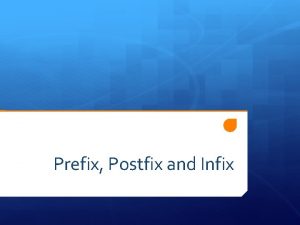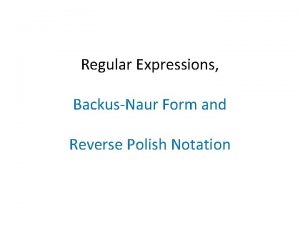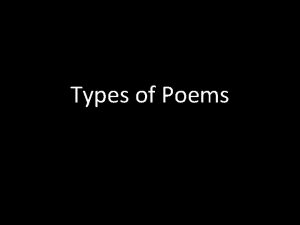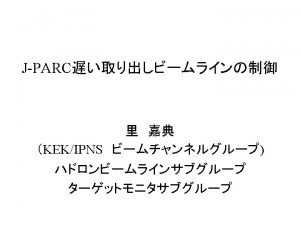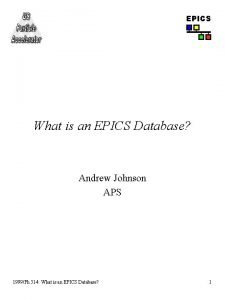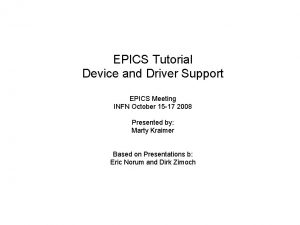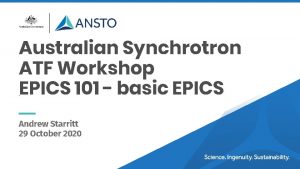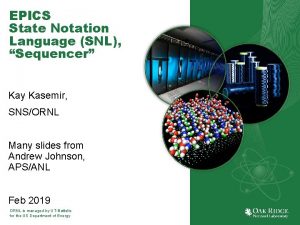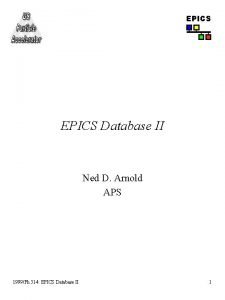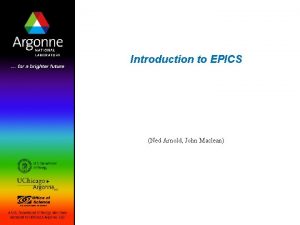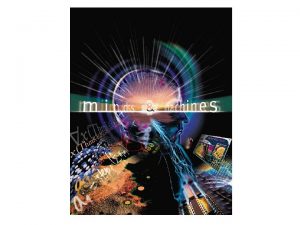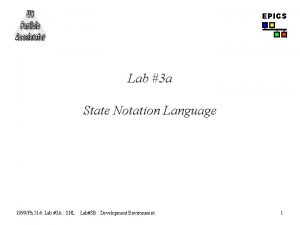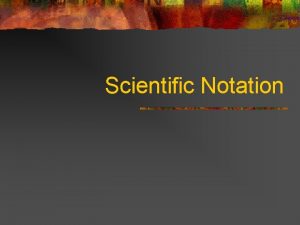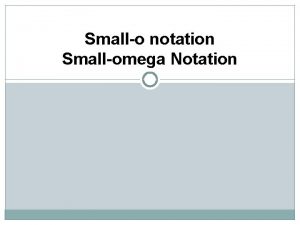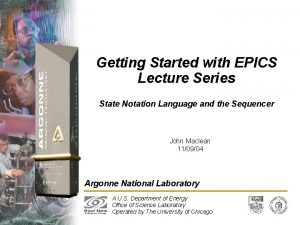EPICS State Notation Language SNL Ned D Arnold

















- Slides: 17

EPICS State Notation Language (SNL) Ned D. Arnold APS 1999/Ph 514: State Notation Language 1

State Notation Compiler and Sequencer u u u EPICS Allows programming of sequential state-oriented operations to run in the IOC The program interacts with the run-time database(s) via channel access Latest manual : http: //www. atdiv. lanl. gov/doc/epics/sequencer/snl_1. 9_man. html 1999/Ph 514: State Notation Language 2

Uses u u u EPICS State machines Startup sequences Enforce prudent operational procedures Watch for likely fault modes that are hard to detect via alarms Implement complex closed loop control schemes Coordinate control of multiple devices 1999/Ph 514: State Notation Language 3

Advantages u u u EPICS Can implement complicated algorithms Can stop, reload, restart a sequence program without rebooting Interact with the operator through string records and mbbo records C code can be embedded as part of the sequence All Channel Access details are taken care of for you File access can be implemented as part of the sequence 1999/Ph 514: State Notation Language 4

Definitions u u u EPICS SNL : State Notation Language SNC : State Notation Compiler sequencer : The tool within the IOC that executes the compiled SNL code Program : A complete SNL application consisting of declarations and one or more state sets State Set : A set of states that make a complete finite state machine State : A particular mode of the state set in which it remains until one of its transition conditions is evaluated to be TRUE 1999/Ph 514: State Notation Language 5

EPICS Basics u The SNL code structure follows a state transition diagram format light_Off state V>5 Turn light on light_On state V<5 Turn light off 1999/Ph 514: State Notation Language state light_off { when (v > 5. 0){ light = TRUE; pv. Put(light); } state light_on { when (v < 5. 0){ light = FALSE; pv. Put(light); } state light_off } 6

Basics (cont …) u u u EPICS Each state has one or more when statements which specify which state to enter next if their condition is met Action statements are executed during the transition from one state to another Access to Process Variables via channel access is accomplished by simply assigning a PV to a sequence variable 1999/Ph 514: State Notation Language 7

A Complete State Program (with 2 state sets) EPICS program level_check ss volt_check { float v; assign v to "ts 1: ai 1"; monitor v; state light_off { when (v > 5. 0) { /* turn light on */ light = TRUE; pv. Put(light); } state light_on } state init { when ( ) { vout = 0. 0; pv. Put(vout); delta = 0. 2; } state ramp } state light_on { when (v < 5. 0) { /* turn light off */ light = FALSE; pv. Put(light); } state light_off } state ramp { when (delay(0. 1) { if ((delta > 0. 0 && vout >= 11. 0) || (delta < 0. 0 && vout <= -11. 0) ) delta = -delta; /* change direction */ vout += delta; } state ramp; } short light; assign light to "ts 1: bo 1"; float vout; float delta; assign vout to "ts 1: ai 1"; ss generate_voltage { } } 1999/Ph 514: State Notation Language 8

More Basics. . . u u EPICS A state can have multiple when statements. The first one to be evaluated to be TRUE will be executed. This allows conditional branching within the sequence program. When entering a state, all when conditions are evaluated in the order given in the source code If no when condition is true, the sequence program task pends until an event occurs, which causes all when conditions to be re-evaluated It is easy to create a loop and consume all available CPU time u When this happens, all CA clients connected to this IOC will disconnect 1999/Ph 514: State Notation Language 9

Example of “Multiple whens” state checks { when(interlock. Chas. Pwr. BI==0) { sprintf(seq. Msg 1, "Electron Gun not ready. . . "); pv. Put(seq. Msg 1); sprintf(seq. Msg 2, "Gun Interlock Chassis off "); pv. Put(seq. Msg 2); } state initial. Checks when(gun. Local) { sprintf(seq. Msg 1, "Electron Gun not ready. . . "); pv. Put(seq. Msg 1); sprintf(seq. Msg 2, "Egun in local control "); pv. Put(seq. Msg 2); } state initial. Checks when(gun. Interlocks. Rdy. CC==0) { sprintf(seq. Msg 1, "Electron Gun not ready. . . "); pv. Put(seq. Msg 1); sprintf(seq. Msg 2, "Interlocks not OK "); pv. Put(seq. Msg 2); } state initial. Checks 1999/Ph 514: State Notation Language EPICS when(interlock. Chas. Pwr. BI && (gun. Local==0) && gun. Interlocks. Rdy. CC) { gun. Auto. Start = 0; pv. Put(gun. Auto. Start); gun. Auto. Stop = 0; pv. Put(gun. Auto. Stop); sprintf(seq. Msg 1, "Push Auto-Start to begin autostart. . . "); pv. Put(seq. Msg 1); sprintf(seq. Msg 2, "Push Auto-Stop to begin autostop. . . "); pv. Put(seq. Msg 2); %% task. Delay(60); } state wait. For. Request } state initial. Checks { when(delay(2. 0)) { sprintf(seq. Msg 1, "Initial Checks"); pv. Put(seq. Msg 1); sprintf(seq. Msg 2, ""); pv. Put(seq. Msg 2); %% task. Delay(60); } state checks } 10

Other Features u Assignment of macros at program startup for multiple copies of same sequence (must specify +r compiler flag) program level_check ("unit=ts 1") u u EPICS In startup script … float v; assign v to "{unit}: ai 1"; ld < level_check. o short light; assign light to "{unit}: bo 1"; seq &level_check, "unit=ts 1" seq &level_check, "unit=ts 2" Arrays (each element can be assigned to a PV) Built-In functions (pg 17 of SNL Manual) Dynamic assignment of PVs to variables Connection Management and status 1999/Ph 514: State Notation Language 11

Other Features u Event Flags (used to sync state sets and monitors) u u ef. Set(name), ef. Test(name), ef. Clear(name), ef. Test. And. Clear(name) Escape to C code u u u EPICS %% escapes a single line %{ }% escapes a block of code Log errors to a log file 1999/Ph 514: State Notation Language 12

EPICS Debugging u seq. Show ioc> seq. Show Program Name Task ID Task Name SS Name xx_RF_Cond 10854616 xx_RF_Cond l 1 Auto. Conditioning bpm. Traject 10838832 bpm. Trajectory. SS xx_auto. Pha 10680172 xx_auto. Phasing 10573424 xx_auto. Pha_1 update. Presets xx_auto. Rf. T 10589876 xx_auto. Rf. Timing value = 0 x 0 1999/Ph 514: State Notation Language 13

Debugging u EPICS seq. Show <task. Id> ioc> seq. Show 10838832 State Program: "bpm. Traject" initial task id=10838832=0 xa 56330 task priority=100 number of state sets=1 number of channels=56 number of channels assigned=56 number of channels connected=56 options: async=0, debug=0, newef=0, reent=0, conn=0 log file fd=3 log file name="/ty. Co/0" State Set: "bpm. Trajectory. SS" task name=bpm. Trajectory; task id=10838832=0 xa 56330 First state = "init" Current state = "wait. To. Plot" Previous state = "plot. With. Beam" Elapsed time since state was entered = 0. 4 seconds) value = 0 x 0 1999/Ph 514: State Notation Language 14

Debugging u EPICS seq. Chan. Show <task. Id> ioc> seq. Chan. Show 10838832 State Program: "bpm. Traject" Number of channels=56 #1 of 56: Channel name: "L 1: PG 1: PM 1: BPM. XPOS" Unexpanded (assigned) name: "L 1: PG 1: PM 1: BPM. XPOS" Variable name: "L 1 PG 1 PM 1_X" address = 11931404 = 0 xb 60 f 0 c type = float count = 1 Value = 0 Monitor flag=1 Monitored Assigned Connected Get not completed or no get issued Status=11 Severity=2 Time stamp = 05/21/99 16: 43: 35. 085407596 Next? (+/- skip count) 1999/Ph 514: State Notation Language 15

Debugging u u u EPICS printf("Here I am in state xyz n"); sprintf(seq. Msg 1, "Here I am in state xyz"); pv. Put(seq. Msg 1); Reload and restart u u seq. Show td xxxxxx ld < my_sequence_program. o seq &my_sequence_program. o 1999/Ph 514: State Notation Language 16

Examples u u u EPICS Compensate for Attenuator Phase Shift when adjusted Automatically check timing of BPM’s E-gun startup Modulator startup Automatic Test Sequences (240 Inputs to the MPS) BPM Trajectory Plot 1999/Ph 514: State Notation Language 17
 Snl scarlet letter
Snl scarlet letter The pen is mightier snl
The pen is mightier snl Stockdale snl
Stockdale snl Snl pandora
Snl pandora Ned language
Ned language Engineering notarion
Engineering notarion Postfix to infix algorithm
Postfix to infix algorithm Regex polish letters
Regex polish letters Polish notation and reverse polish notation
Polish notation and reverse polish notation Blank verse poem
Blank verse poem Epics channel access
Epics channel access Epics database
Epics database Most famous epics
Most famous epics Facts about beowulf
Facts about beowulf Pericles and the bull
Pericles and the bull Epics tutorial
Epics tutorial What is an epic hero
What is an epic hero Epics calc record
Epics calc record

